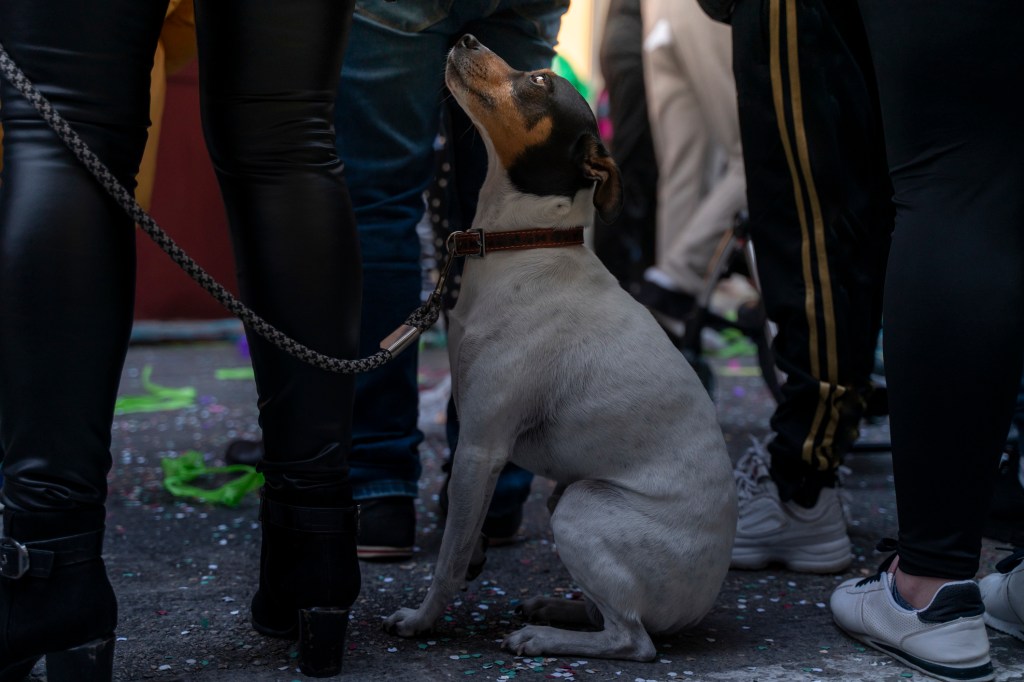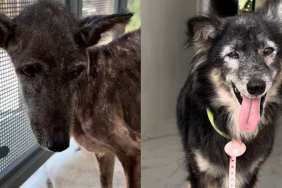Anxiety in dogs is similar to social anxiety in people. As such, it’s an extreme fear or stress related to social situations. Dog anxiety is normal for many dogs and can cause changes in behavior when exposed to unfamiliar people, animals, or places. But at what point does this shift from general stress to deeper social anxiety issues? Knowing the signs of anxiety in dogs can help dog parents address problems early on before they intensify.
What is dog social anxiety?
Social anxiety in dogs refers to anxiety, fear, or nervousness that dogs experience in social settings or interactions. Just as humans can suffer from social anxiety disorder, some dogs struggle with similar symptoms in social contexts.
A dog with social anxiety may appear frightened, cowering, or withdrawn when exposed to unfamiliar people, dogs, children, crowds, or other scenarios involving social interaction. The dog may try to escape or avoid the situation triggering its anxiety. Shaking, tail tucking, hiding, barking, and even aggression can occur in response.
Causes of social anxiety in dogs
Lack of socialization as a puppy: Puppies go through critical socialization periods starting at 3 weeks old. If they don’t get properly introduced to new people, dogs, environments, etc. during this time, they are more likely to develop fear and anxiety later on. Missing out on positive experiences while young sets them up for problems.
Genetics and personality: Like humans, some dogs seem to be genetically predisposed to anxiety. Shy, nervous, timid and cautious personality types may be more vulnerable. Breed can also play a role, as some breeds tend to be more prone to anxiety issues.
Trauma: Negative past experiences can contribute to social anxiety like overly harsh discipline or punishment, physical or verbal abuse from humans, or attacks/aggression from other dogs. These traumatic events help create associations between stimuli like crowds or strangers and fear.
Medical issues: In some cases, an untreated medical condition such as hypothyroidism can cause or worsen anxiety in dogs. A vet check can rule out this possibility.
Environment and confidence: Dogs lacking mental stimulation, exercise, predictability in their environment or clear structure and leadership from owners are more likely to develop confidence issues that may spill over into social phobias and avoidance. Supporting their needs builds confidence.
The underlying cause of social anxiety may not always be obvious. More often it results from the interplay between nature and nurture – genes, personality tendencies, environment and life experiences all feeding the dog’s fearful perceptions of uncertain social situations and stimuli. Figuring out what factors are at play takes work, but the effort pays off in better focused treatment strategies tailored for an anxious dog.
Symptoms of social anxiety in dogs
Not to be confused with separation anxiety, extreme reactions when meeting strangers is one of the most common red flags for social anxiety in dogs. Anxious dog symptoms can include aggressive barking, lunging, or hiding behind their owner when new people approach. Some anxious pups may even refuse to walk or are too distracted to obey commands when in public areas.
Overly stressed body language like a tucked tail, flattened ears, or yawning outside of feeling tired are other symptoms. Social events also may lead to diarrhea, vomiting, or loss of appetite due to the mental strain.
Signs of anxiety
- Restlessness, agitation
- Pacing, shaking, panting
- Clinging to/following owner
- Hiding or attempting to escape
- Sensitivity to noise or touch
- Destructive behavior
Social anxiety vs. depression
While anxiety and depression may look dramatically different, they can both contribute to your dog’s well-being. Signs of depression can include lethargy; lack of interest in toys, treats, or activities; and changes in appetite.
Dog breeds susceptible to social anxiety

Certain breeds of dogs are considered more genetically prone to developing social anxiety and fearfulness. Some breeds and backgrounds known to be vulnerable to social anxiety issues include:
- Shy, “nervous” breeds: This includes breeds like Greyhounds, various Terriers, herding breeds, livestock guardian dogs, Chihuahuas, Papillons, and many toy dog breeds. They tend to startle more easily or be suspicious of new things.
- Fearful rescue or shelter dogs: Dogs confined long-term or previously abused often exhibit heightened fear and anxiety due to negative experiences. Their past trauma shapes nervous dispositions.
- Lack of early socialization: All puppies require exposure to various people, places, and stimuli during a prime developmental stage for proper social skills to emerge. Missing out contributes to wariness later on.
- Older and senior dogs: Advancing age can bring about confusion, neurocognitive issues like dementia or canine cognitive dysfunction, and hearing or vision decline that can manifest like social anxiety in dogs unaccustomed to the changes.
While genetics contribute to a dog’s base temperament, environmental factors play an enormous role in determining social aptitude. Boosting confidence through reward-based training, avoiding punishment for nervous behaviors, and maintaining exercise or routines can help dogs prone to social issues. It’s often a management issue more than anything inherently “broken.” The key is knowing and accommodating limits unique to that individual dog’s needs.
Diagnosing social anxiety in dogs
The first step is scheduling a veterinarian exam to rule out a medical trigger. If health isn’t the culprit, begin logging details about surroundings and situations when the anxiety emerges. This helps identify specific triggers to address.
Diagnosing social anxiety in dogs can be challenging, but there are some key signs veterinarians and trainers look for:
- Fearful reactions around strangers, unfamiliar dogs, children, loud noises, or novel environments. These may include trembling, hiding, barking, or avoidance behaviors.
- Problems being separated from owners, severe distress when left alone, clingy behaviors.
- Poor performance and reactions in group training classes, dog parks, boarding facilities or when meeting new people at home.
- Aggressive behaviors like growling or lunging at unfamiliar people or dogs that encroach on their space, resulting from underlying anxiety.
- Chronic stress signals like excessive panting, whining, yawning and lip licking in social settings.
- Destructive behaviors when left alone stemming from separation anxiety.
Veterinarians will aim to rule out potential medical causes through exams and testing thyroid levels and other health markers. Getting a detailed history of the dog’s behaviors and assessing reactions directly in social settings helps inform the diagnosis.
There are no definitive tests for canine social anxiety itself. The diagnosis is mainly based on observation of behaviors, reactivity patterns and signs of fear/avoidance in triggering scenarios. Ruling out other potential causes of these reactions is an important part of making an accurate diagnosis that will guide effective treatment plans. Addressing social anxiety issues early maximizes a dog’s chances of overcoming them through behavioral training, desensitization, medication, or often a combination approach tailored to the individual dog.
Dog anxiety treatment and medications
In some cases, prescription anti-anxiety medications like Trazodone may help enough for dogs to relearn old associations. Supplements like pheromones or CBD are also safer first options. Some other anxiety medications include:
How to prevent dog social anxiety
Here are some tips for helping prevent social anxiety in dogs:
Proper socialization: Ensuring dogs receive extensive positive socialization during the critical 3-16 week puppyhood window lays crucial foundations. Puppies should be gradually exposed to many types of people, environments, sounds, and other dogs in a controlled, rewarding way.
Confidence building: Boost confidence through reward-based training, allowing safe explorations, providing mental stimulation, and setting dogs up for success. Confident pups are less likely to develop social anxiety.
Careful breeding: Ethical, responsible breeders aim to breed both parents with sound temperaments, free of excessive fearfulness or anxiety issues that can be inherited. Screening adults’ behavior helps reduce likelihood of anxious puppies.
Management not punishment: If a dog shows fearful reactions or avoidance behaviors, manage the situation calmly without punishment. Harsh reprimands can make anxiety worse in fearful dogs. Patience and counterconditioning work better.
Proactiveness: Be alert for early warning signs of social struggles as a puppy enters adolescence (4-6 months). Intervening promptly with socialization setbacks through positive training maximizes outcomes. Don’t take the “wait and see” approach.
Consistent leadership: Providing stability, routine, and confident guidance on appropriate behaviors creates security versus exacerbating anxiety. Clear communication reduces uncertainly dogs may find unsettling.
Prevention is always preferable to treatment when it comes to problematic anxiety. Paying attention to proper socialization foundations, genetics, early interventions at first signs, rewards-based training, and building confidence are keys to avoiding full-blown social anxiety down the road.
Watch for common anxiety signs
If your senior dog is showing symptoms like panting, trembling, irritability, changes in appetite/sleep, clinginess, or lethargy, pay close attention as these could indicate anxiety. Sudden separation anxiety or fear of noises/strangers also merit a closer look.
Get a veterinary evaluation
Consult your vet if you notice these anxiety signs to rule out medical conditions or pain that could be contributing. Identifying and addressing underlying health issues is an important first step.
Consider Cognitive Dysfunction
Increased anxiety can be a symptom of canine cognitive dysfunction syndrome (CDS), similar to dementia or Alzheimer’s disease in humans. Other aspects of CDS include disorientation, social issues, sleep pattern changes, housetraining accidents, activity changes, and anxiety. Have your vet evaluate for CDS.
Take proactive anxiety management steps
While evaluating medical causes, also take steps like sticking to a routine, adjusting the home environment to be safer, providing comfort items when alone, trying supplements, and asking about medication if anxiety is severe. Don’t scold accidents as this can worsen anxiety.
Partner with your veterinarian
Work closely with your vet on recommendations for medical conditions and anxiety/CDS interventions. The earlier treatment starts, the better the chances of improving your senior dog’s quality of life and minimizing distress from anxiety.
Living with a socially anxious dog

While social anxieties likely can’t be fully “cured,” they can be successfully managed. This allows anxious dogs to live happy, enriched lives with the right owner commitment.
Stay alert to surroundings on walks to avoid known triggers. Skipping crowded events reduces unnecessary stress as well. Instead, focus playtime and exercise on predictable environments using known people. Keep introductions to strangers or new places very limited and controlled.
With some adjustments, pet parents can continue to enjoy their bond with their dog. What’s more, having realistic expectations of a canine’s social abilities will reduce anxiety for everyone. That said, a dog owner should know when actively challenging those boundaries is both necessary and unnecessary.
The key is learning the individual dog’s signals and respecting when they hit capacity by removing them from an untenable situation. While social anxiety seems strictly behavioral, it’s no less real of a struggle. Paying attention to a dog’s distress and addressing the root cause is essential, just as it would be for a human family member battling similar issues. As in most cases, patience and compassion go a long way.









